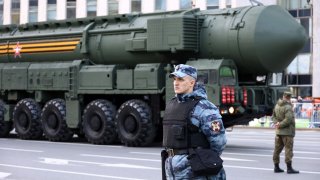The Risk of an Accidental Nuclear Exchange is Growing
As the conflict in Ukraine escalates, the potential for miscommunication or technological failure highlights the urgent need for diplomatic solutions.
Russia’s historical paranoia casts a long shadow. This paranoia is deeply rooted in a history of invasions, from the Polish-Lithuanian Commonwealth in the 1600s, Sweden in the 1700s, and Napoleon in the 1800s to Germany in the 20th century.
These events have shaped Russia’s defensive posture and complicated Western attempts to predict its responses to military escalations. The West, often projecting its perspectives onto Russia, fails to fully grasp these historical and cultural differences, leading to a dangerous game of assumptions. This is especially true when considering that, at present, only Russia can unleash an apocalypse on the United States that could functionally end its existence in under thirty minutes.
While much contemporary concern regarding nuclear escalation in the context of the Russia-Ukraine War focuses on Russian President Vladimir Putin’s rhetoric regarding nuclear weapons and the recent revision to Moscow’s nuclear doctrine, the real danger lies somewhere else. Regarding acts of intentional policy, deterrence is likely to hold. This deterrence does not apply to misperception or miscommunication-related accidents. Accidents commonly arise in the fog of modern crises. As decision-makers grapple with overwhelming volumes of information, the risk of catastrophic misinterpretations looms large.
Technological failures, especially in Russia’s relatively outdated nuclear early warning systems, exacerbate this risk. A recent example is Ukraine's drone strike on Russia’s early warning system in May 2024, in which a Ukrainian drone traveled over 1,800 kilometers to strike the Aramvir radar station. Such incidents could inadvertently escalate tensions by providing misleading information. Though unlikely, the potential for a nuclear response from Russia cannot be entirely dismissed.
History has shown us how close the world has come to nuclear disaster due to misunderstandings and technical errors.
Take, for instance, the story of Vasili Arkhipov in 1962. During the Cuban Missile Crisis, Arkhipov was aboard the Soviet submarine B-59, which was authorized to launch a nuclear torpedo if attacked. In a moment of immense pressure, Arkhipov convinced the captain to delay the decision, averting a potential nuclear war. His calm and reasoned judgment in the face of chaos saved the world from disaster.
Fast-forward to 1979, when a false alarm at the North American Aerospace Defense Command (NORAD) nearly led to a U.S. nuclear strike on the Soviet Union. A simple error—a training tape mistakenly inserted into a computer—almost triggered a catastrophe. The error was caught just in time, preventing disaster and serving as a stark reminder of how close we can come to the brink.
Last week marked the forty-first anniversary of the day Stanislav Petrov, a Soviet officer, faced a similar situation and likely saved the world. The early warning system he was monitoring falsely indicated a U.S. missile launch. Petrov, trusting his instincts over protocol, identified the alert as a false alarm and chose not to report it as an attack—his decision. However, a violation of Soviet protocol averted a retaliatory strike and potential nuclear conflict.
Then there was the 1995 Norwegian Rocket Incident, where Russia mistook a peaceful scientific rocket launch over Norway for a nuclear missile attack. Despite initial alarms, Russian leadership decided not to retaliate, thanks to the trust between Presidents Yeltsin and Clinton—a trust that is noticeably absent in today’s geopolitical climate.
These incidents underscore the precariousness of nuclear deterrence, where individual decisions and sheer luck have prevented catastrophe. The legend of Prometheus, who defied the gods to bring fire to humanity, serves as a poignant metaphor for the dangerous gift of nuclear technology—potentially beneficial yet fraught with danger.
Just as Prometheus’s gift had unintended consequences, so too does the power of nuclear weapons, which still hangs over us like the sword of Damocles once referred to by President Kennedy.
Henry Kissinger has long emphasized the shared interest in avoiding the “unthinkable” nuclear war. His work on nuclear weapons highlighted the importance of mutual understanding of risks to prevent escalation. Kissinger’s insights remain relevant, reminding us to manage atomic arsenals carefully to avoid accidental or unauthorized use.
As the conflict in Ukraine unfolds, the potential for miscommunication or technological failure highlights the urgent need for diplomatic solutions. The stakes are high, and the danger of getting it wrong extends far beyond Ukraine.
Unfortunately, this in-depth conversation is not happening nearly enough in public. It should. Many Americans are likely entirely oblivious to the threat of destruction hanging over their heads every minute of every day, as well as how much gambling their government is doing when it comes to Russia. They should probably read Annie Jacobsen’s recent book, Nuclear War: A Scenario. While it sketches a somewhat unlikely confluence of events, it is not fantasy. Nuclear conflict is all too possible, and its results would be apocalyptic. Moreover, it is even more likely to manifest itself in the fog of the Ukraine War, especially as Ukraine starts threatening to use an indigenously designed ballistic missile.
It is time to cut a deal. Vice presidential candidate JD Vance recently outlined elements of a realistic scenario should he and former President Trump win in November.
While the outcome is unlikely to satisfy moral purists, catastrophe risks will only grow the longer the conflict is left burning. If mushroom clouds emerge, it won’t matter what the moral arguments about the war in Ukraine are.
In the words of J. Robert Oppenheimer, “We may be likened to two scorpions in a bottle, each capable of killing the other, but only at the risk of his own life.” This quote encapsulates the delicate balance of nuclear deterrence and the imperative to prevent escalation, even at the cost of moral purity.
Greg R. Lawson is a Contributing Analyst with Wikistrat. Follow him on LinkedIn and X @ConservaWonk.
Image: Shutterstock.com.

